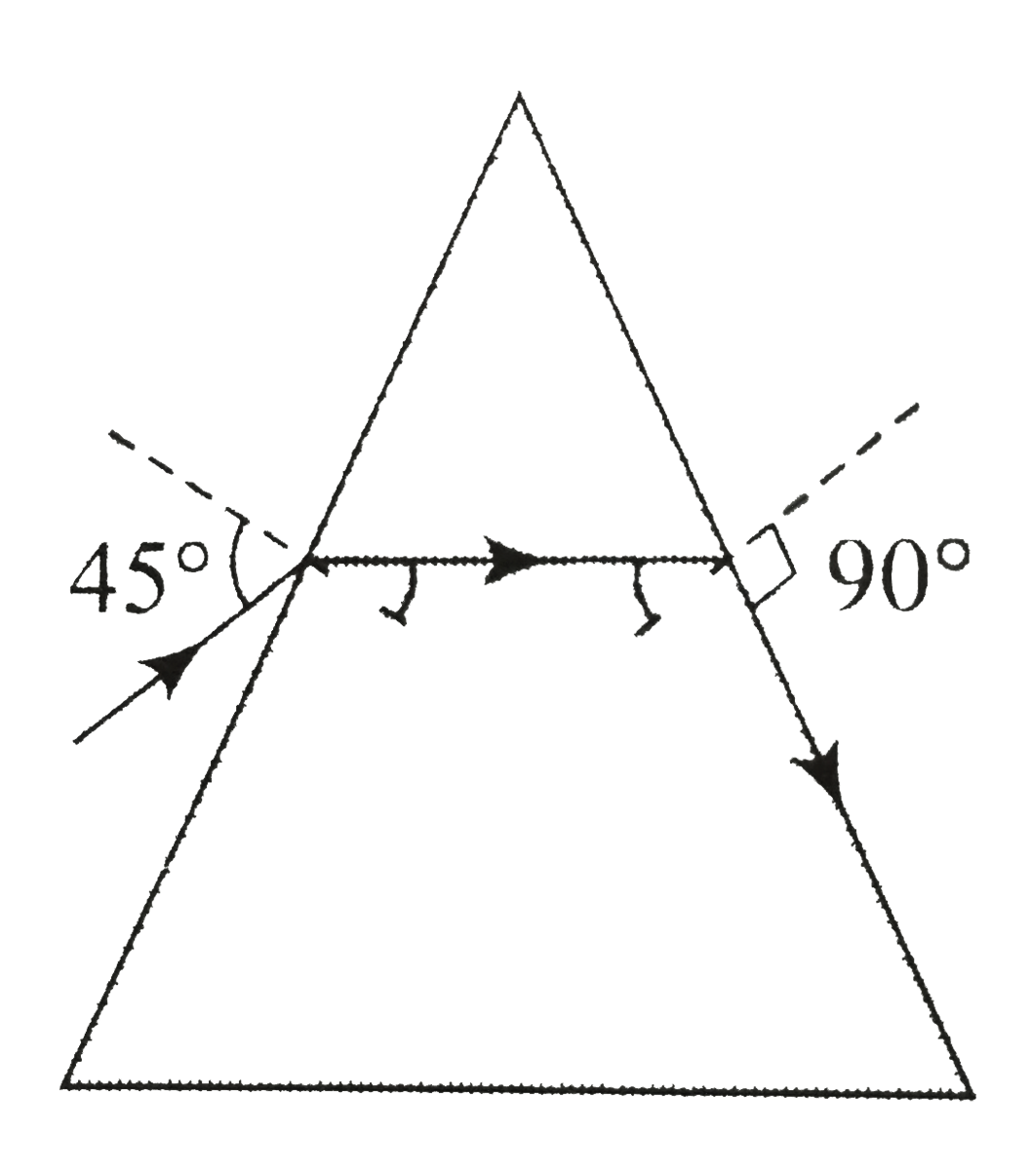A ray of light is incident at small angle I on the surface of prism of small angle A and emerges normally from the oppsite surface. If the refractive index of the material of the prism is mu, the angle of incidence is nearly equal to
μA
μA2
A/μ
A/2μ
The correct Answer is:A
To solve the problem, we need to determine the angle of incidence (I) of a ray of light incident on a prism with a small angle (A) and a refractive index (μ), given that the ray emerges normally from the opposite surface of the prism.
1. Understanding the Geometry of the Prism:
- The prism has an apex angle A.
- A ray of light is incident at an angle I on one surface of the prism.
- The ray emerges normally from the opposite surface, which means the angle of emergence e=0.
2. Using the Relation for Deviation:
- The angle of deviation δ is related to the angle of incidence I, angle of emergence e, and the angle of the prism A by the formula:
δ+A=I+e
- Since e=0, we can simplify this to:
δ+A=I
3. Finding the Angle of Deviation:
- The angle of deviation δ for a prism can also be expressed in terms of the refractive index μ and the angle of the prism A:
δ=A(μ−1)
4. Substituting the Deviation into the Relation:
- Now we substitute δ into the deviation relation:
A(μ−1)+A=I
- This can be rearranged to:
I=A(μ−1)+A
- Simplifying this gives:
I=Aμ−A+A=Aμ
5. Conclusion:
- Therefore, the angle of incidence I is nearly equal to:
I≈Aμ
Final Answer:
The angle of incidence I is nearly equal to Aμ.
- The prism has an apex angle A.
- A ray of light is incident at an angle I on one surface of the prism.
- The ray emerges normally from the opposite surface, which means the angle of emergence e=0.
- The angle of deviation δ is related to the angle of incidence I, angle of emergence e, and the angle of the prism A by the formula:
δ+A=I+e
- Since e=0, we can simplify this to:
δ+A=I
- The angle of deviation δ for a prism can also be expressed in terms of the refractive index μ and the angle of the prism A:
δ=A(μ−1)
- Now we substitute δ into the deviation relation:
A(μ−1)+A=I
- This can be rearranged to:
I=A(μ−1)+A
- Simplifying this gives:
I=Aμ−A+A=Aμ
- Therefore, the angle of incidence I is nearly equal to:
I≈Aμ
The angle of incidence I is nearly equal to Aμ.
Topper's Solved these Questions
- BOOK - DC PANDEY ENGLISHCHAPTER - RAY OPTICSEXERCISE - medical entrance special format question23videos
RAY OPTICS
- BOOK - DC PANDEY ENGLISHCHAPTER - NUCLEIEXERCISE - C MADICAL ENTRANCES GALLERY46videos
NUCLEI
- BOOK - DC PANDEY ENGLISHCHAPTER - REFLECTION OF LIGHTEXERCISE - Subjective9videos
REFLECTION OF LIGHT
Similar Questions
A ray is ihncident at an angle of incidence ii on one surface of a prism of small angle A and emerge normally from opposite surface. If the refractive index of the material of prism is μ. the angel of incidance I is nearly equal to
View SolutionA ray of light is incident at 60∘ on one face of a prism of angle 30∘ and the emergent ray makes 30∘ with the incident ray. The refractive index of the prism is
View Solution
Knowledge Check
- Question 1 - Select One
A ray of light is incident at 60∘ on one face of a prism of angle 30∘ and the emergent ray makes 30∘ with the incident ray. The refractive index of the prism is
A1.732B1.414C1.5D1.33
A monochromatic light is incident at a certain angle on an equilateral triamgular prism and suffers minimum deviation . If the refractive index of the material of the prism is √3, them the angle of incidence is :
View SolutionA ray of light is incident at 65∘ on one face of a prism of angle of 30∘ and the emergent ray makes 35∘ with the incident ray. The refractive index of the prism is:
View SolutionThe light ray is incidence at angle of 60∘ on a prism of angle 45∘ . When the light ray falls on the other surface at 90∘ , the refractive index of the material of prismμ and the angle of deviation δ are given by
View SolutionThe light ray is incidence at angle of 60∘ on a prism of angle 45∘ . When the light ray falls on the other surface at 90∘ , the refractive index of the material of prismμ and the angle of devaition δ are given by
View SolutionIn an isosceles prism of angle 45∘, it is found that when the angle of incidence is same as the prism angle, the emergen ray grazes the emergent surface.
Find the refractive index of the material of the prism. For what angle of incidenc, the angle of deviation will be minimum?
 View Solution
View SolutionA Ray of light is incident at an angle 60° on one face of a prism which has protecting angle of 30°. The emerging ray deviates through 30° from incident light. The refractive index of material of prism is
View SolutionWhen a ray of light is incident normally on one refracting surface of an equilateral prism (Refractive index of the material of the prism =1.5)
View Solution

